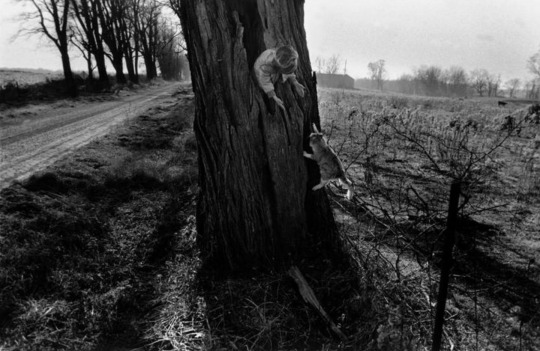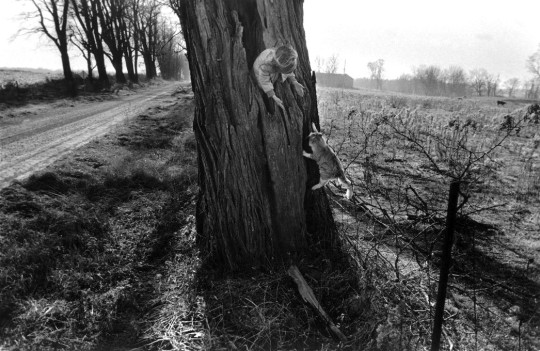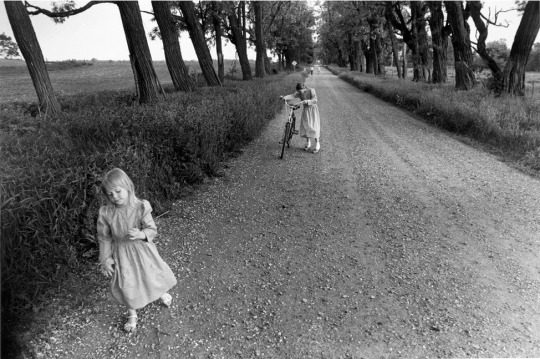#lambton county
Text

Larry Towell, Naomi in Hollow Tree with Cat, Lambton County, Ontario Canada, 1990
138 notes
·
View notes
Text
The Faerie Paths
In the neighborhoods of Rosedale and Wiltshire there are a number of streets with multiple crabapple trees on the boulevards. The crabapple is a tree sacred to Manannnan mac Lir, a prominent member of the Irish, Welsh, and Scottish gods whose primary job is a mover between worlds. When crabapples are planted along a travel route the path becomes aligned with the passages he uses to go from Earth to the Otherworld. As a result other less powerful faerie folk are able to use those paths as well. If one walks along these roads at certain times of the year or during the twilight hours year round one has a decent chance to glimpse otherworldly travellers. In order to do so one must remember to remain quiet and watch from the corners of one’s eyes. Speaking aloud and turning to look directly at the beings one sees causes them to vanish. Alternatively carrying a open bottle of water with one may invite a interaction if one is brave enough to do so. Though if approached only hold the bottle out and remember not to stare. Any kind of rudeness is likely to result in faerie mischief later on.
The folk encountered in this area are likely to be solitary travellers of various races none of which will be malicious or hostile unless treated similarly. That being said if large groups are seen it is best to leave the road and walk on to the boulevard. Such groups are often the retinues for the Lords and Ladies and they may take a person’s subtle self along with the group if they take a fancy to a nearby mortal.
#rosedale neighbourhood#wiltshire neighbourhood#faerie paths#crabapple trees#manannan mac lir#sarnia#ontario#lambton county#otherworldly travellers#faerie folk#local faerie lore#Lords and Ladies#faeries
4 notes
·
View notes
Photo

“Scene and Victims of Crossing Crash,” Border Cities Star. October 26, 1931. Page 13.
----
WHEN Angus Maw, Enniskillen Township farmer, drove his car through the gates at the C.N.R. crossing in Wyoming, Ont., early Sunday morning, he and his wife lost their lives as their car struck the International Limited. In the top photo is shown the crossing where the fatality occurred. At lower left are Mr. and Mrs. Maw, the victims, and lower right is shown the wreck of their car.
#wyoming ontario#lambton county#level crossing#hit by a train#railway crossing#farming in canada#car crash#motor vehicle accident#wrecked car#fatal crash#death of the automobile#life of the automobile#great depression in canada#small town ontario
0 notes
Photo










Cristina + Dustin
Why do mosquitoes have to like sunsets just as much as we do?! ...They may have stolen our blood but they couldn’t stop the epic arts.
Engagement Session by Sarnia Photographer Daniel McQuillan Photography at the Green Hill Gardens in Wilksport, ON
#daniel mcquillan#daniel mcquillan photography#daniel mcquilllan#wilkseport#wilkesport#sarnia#wilksport#greenhill gardens#Lambton county photographer#BEST PHOTOGRAPHER#best lambton county photographer#Lambton County#photogrpahers#best sarnia wedding photographer#Sarnia Ontario#sarnia wedding#sarnia wedding photography#sarnia wedding photographer#sarnia wedding photographers#Wedding#weddings#wedding photography#drone photography#drone engagement#modern photographer#in camera effects#in camera double exposure#in camera techniques#in camera photography#influential photographers
1 note
·
View note
Text
About: The True Tale of the Sockburn Worm
So the story can be found in two places. It’s online (here: https://www.silversunbooks.com/post/monsters-masquerades-issue-6) and a print version of the magazine is on amazon (here: https://www.amazon.co.uk/dp/1913786323?&linkCode=sl1&tag=josijaff-21&linkId=2297ab50332fcde6cd3f3cf0faed7f8e&language=en_GB&ref_=as_li_ss_tl)
Ok so I may have said I’d write about my other stories over the next few days, but I’m indecisive. So I’m gonna write about my first short story now instead.
So the ‘True Tale of the Sockburn Worm’ was published in issue 5 of Indie Bites which was themed all around monsters and masquerades. When I actually wrote the story I hadn’t planned on publishing it, my original intention had been to just write my weird little stories and show them among my friends. But then I stumbled across Indie Bites on twitter and decided that since the story closely matched the theme of the magazine issue that I should submit it. A few months later I go an email saying it had been accepted! And after a few more weeks a few changes had been made and it was published! I still remember how excited I was to have my very first short story published
But what is the legend of the Sockburn Worm? Spoilers for the story below.
So the ultra short version of the original tale is that an 11th century knight called Sir John Conyers kills a ‘worm’ (otherwise known as a wyvern) who is stalking his families land in Sockburn, County Durham with a falchion. Most retellings then focus on the falchion and how there was a ceremony of the prince-bishops of Durham receiving and then giving back the sword when they were first appointed.
I like that little legend, though I was bothered with the lack of detail given to the fight itself. So I ended up creating a retelling of it from the perspective of Sir John Conyers. In the short story Sir Conyers is an alcoholic man who boasts of his past deeds while chugging pints of beer. We meet him in one such retelling where he gradually gets drunker and gets details wrong, such as the suddenly appearing-and-disappearing Marie. This is all done from the perspective of Sir Conyers speaking directly to the audience.
So the main ‘thing’ of the story is playing around with the standard knights tale by way of an unreliable narrator. The whole point of Sir Conyers is that the reader is never sure when he’s telling the truth. So you’re left doubting the whole of the tale even while he insists that its the truth. I’ll readily admit that it’s not the ‘deepest’ of short stories but I still enjoy the inversion. Though I am pretty biased in favour of it.
The editing process did definitely benefit the story though, with the main two changes being a lame joke being taken out plus the insinuation against the prince-bishop being significantly changed to something tamer.
Looking back on it is strange. I’ve only been writing for 5ish months now, but it feels like I’ve already developed a lot since I wrote this. But I still enjoy it, it’s a more light-hearted piece that’s steeped in the history of my home county.
Also, I have a fun fact about the story. It came around as I stumbled across the Sockburn Worm while looking for folklore creatures of County Durham for a novel idea I had. I still plan on writing that novel, so maybe Sir John Conyers will make a return one day ;)
And so ends all my thoughts on ‘The True Tale of the Sockburn Worm’. For anyone who has read the story, thank you and I hope you enjoyed it (and I hope you read the other stories in the magazine too!)! Also I gotta thank the editor, Asha, who suggested some great changes to the story that made it much better. Hope you all have a great day!
#fantasy#short story#wyvern#sockburn worm#indie bites#fuck the lambton worm#fantasy fiction#just realised I said so way too much#fiction#county durham
4 notes
·
View notes
Text

'leadgate and lambton earthworks, excavator driver - steve fox' county durham, 1988-9 in a collaboration with nature - andy goldsworthy (1990)
116 notes
·
View notes
Photo

Naomi Towell with her cat in a hollow black locust tree, Lambton County, Ontario, Canada, 1990 - by Larry Towell (1953), Canadian
83 notes
·
View notes
Text

The death of 14-year-old Karen Caughlin has been at the centre of a 44-year-old cold case in Sarnia, Ontario, Canada.
Karen was last seen alive at approximately midnight on the 16th of March, 1974. She had spent the evening roller skating with her friends at Rose Gardens in Point Edward. In the mid-morning hours of that morning, a farmer discovered the lifeless body of Karen near the side of Plowing Match Road between Churchill Line and Lasalle Line in Lambton County. Her body was riddled with bruises and contusions.
It was initially believed that Karen had been brutally beaten to death. However, it was later released that her injuries were consistent with being hit by a vehicle. It had been particularly foggy in the early morning hours and its presumed that somebody had accidentally ran into Karen as she walked home. What was clear, however, was that whoever knocked Karen down, decided that instead of seeking medical help, they decided to transport her body 23 kilometres into the ditch where she was left to die from her injuries.
46 notes
·
View notes
Text

The Lambton Wyrm of county Durham: 30x30cm lino print.
#folklore#english folk art#fae folk#folk magic#folk art#faecore#faerie#faery aesthetic#fae core#fairy tales#dragons#art#my art#aesthetic#cottagecore#linocut#linoprint#linocarving#lino print#printing#art print#medieval aesthetic#medieval core#knightcore#serpent#folkcore#fairycore#fairy aesthetic#fairy cottage#fairies
13 notes
·
View notes
Text

Larry Towell
Lambton County
Ontario, Canada, 1991
63 notes
·
View notes
Photo

Mennonites. Lambton County, Ontario. 1990.
Larry Towell/Magnum Photos
22 notes
·
View notes
Text
A dragon from Librum Prodigiosum! The Lambton Worm, from British mythology! Originating in a legend from county Durham- telling the story of John Lambton and his battle with the evil beast in the River Wear and his subsequent curse!

#digital art#digital illustration#fantasy#art#folklore#mythology#librum prodigiosum#monster#mythical creatures#creature#mythology art#artists on tumblr#dragon art#dragon#lambton worm#British mythology#mythologyart
26 notes
·
View notes
Photo

“Collection Of Scrap In City Starts,” Windsor Star. November 14, 1942. Page 5 & 6..
----
Metal and Rubber Picked Up; Windsor Follows After Drive Begun in Rural Areas
---
Old bed springs, tin cans, kettles, pails, overshoes, bathing caps, heavy duty tires, lawn-mowers, typewriters, piping, sheet metal, stoves and heaters children's tops, and a thousand and one other pieces of scrap metal and rubber were contributed by Windsorites this morning to the salvage drive.
PLACED ON CURB
Householders put their contributions on the curbs in front of their homes, and 30 city trucks started collection at 9 a.m., with 100 other trucks loaned by city firms, joining in the work at noon.
The amount of salvage contributed showed a determination on the part of residents of the city that the victorious sweep of the United Nations will not be halted by lack of equipment, and citizens made efficient and effective clearings of attics, basements, garages and tool sheds for the badly needed salvage.
Campaign headquarters reported at noon that between 200 and 250 tons of scrap metals and rubber would probably be gathered up in Windsor, despite a salvage drive having taken place last June.
ACTIVITY IN RURAL AREAS
They reported "a lot of activity in the three counties of Essex. Kent and Lambton where all residents of rural and urban areas are hard at work.
During the week, school children collected keys, locks and hinges at the schools and these articles were also picked up by the trucks today.
Metal from a big electric sign of the Ferry Morse Seed Company of Detroit, at the corner of Sandwich and McDougall streets, was pledged to the scrap drive yesterday, and dismantling of the sign will take place early in the week. John Milne, superintendent of the company, authorized the contribution of the sign.
Canvassing of city homes to explain the urgency of the need for scrap metals and rubber was conducted by the women of Windsor, under direction of Mrs. H. J. Arbuckle, vice-chairman of the local committee.
KENT TOTAL GROWS
CHATHAM, Nov. 14 Warden W. L. Hills, of Highgate. estimated this morning that perhaps half a million pounds of scrap would be collected in Kent County before the current all-out tri-county drive for scrap iron ended. There was no way, he said, of estimating how much had been collected yesterday or what would be gathered today.
The scrap is being piled In depots in each of the ten townships of th-county and being taken up by independent collectors. It would be impossible for another week at least. Warden Hills said, to make any sort of a fair estimate of the total.
Besides his calculations on the basis of his own Township of Orford which was well above the average, and in which about 100,000 pounds was taken yesterday and today, the warden thought that half a million pounds might not be an exorbitant figure when the campaign was completed.
Anticipating a huge success in all three counties in the big drive for scrap metal which in some places will end with collection today, J. O. Laird, of Windsor, provincial organizer, salvage campaign office, department of national war services, said here last night that Harwich and Orford townships likely would be among the foremost contributors in Kent. Here in connection with the drive, Mr. Laird said that when the collections were completed some other townships might show equally good results.
While Friday and today were the principal days set aside for gathering of scrap iron in Kent, Essex and Lamb- ton counties, Mr. Laird believed that in most parts of the rural areas, collecting would likely continue for another 10 days. But even last night he was able to report a surprisingly large amount of crap metal already hauled to the various dumps in Kent and other counties.
PRAISES HARWICH
He particularly mentioned Harwich, saying that its 12 collection centres were piled high after a thriving busi ness had been done in gathering scrap. The scrap gathered at the depots will be picked up by scrap dealers who will purchase it through local salvage committees and all profits will be for war work.
Telling his appreciation of the fine response to the appeal for needed metals, Mr. Laird mentioned particu larly the work of school children who helped materially in the campaign. Drawing attention to The Windsor Daily Star, he said that it had "given marvelous help in the publicity campaign."
He asked that citizens of the three counties continue their efforts to find scrap and get it to the stations for collection, since it was of the utmost necessity that Canada have a million pounds of scrap before winter sets in.
SOUTH ESSEX
LEAMINGTON, Nov. 14. Very encouraging results are being reported in this district over the amount of scrap rubber and metals that is being unearthed by patriotic residents of this part of Essex County, during the tri-county salvage drive that is now under way.
At Kingsville, trucks started to pick up this much needed material yesterday and expect to have it completed by tonight. In Mersea Township the collection will be carried out next week and it is expected that a good yield of salvage material will be brought to this town by trucks from the farming community about here.
Unlike other parts of Western Ontario, this section has very few large collections of scrap lying about, this is because a very active salvage committee has been operating here and in Kingsville since the outbreak of the war. This committee has turned many thousands of tons of material into the war effort by their diligent work along this line.
LAMBTON RESPONSE GOOD
SARNIA. Nov. 14. Aside from the immediate response, which is better than many expected, the current scrap campaign in Lambton County is making hundreds of home owners more "scrap conscious," and the result likely will be a much greater volume of discarded goods turned in at regular collection periods in the future months or years, officials said today.
"For instance," a canvasser in Sarnia Township said last night, "one farmer who hasn't before turned over a pound of scrap gave us a hundred pounds of metal and said that as he starts overhauling his farm machinery there will be a few more hundred pounds."
Salvage officials reported that the Lambton campaign is proceeding on schedule in most places. Many of the municipalities started collecting this week, but a number have set aside dates next week for assembly community scrap heaps.
#windsor#chatham#sarnia#leamington#kingsville#scrap metal#scrap rubber#rubber rationing#war production#salvage conscious#Salvage campaign#national salvage office#essex county#lambton county#kent county#war effort#total war#canada during world war 2
1 note
·
View note
Text










Lindsay + Josh
Can safely state, 2023 is off to an epic start - Had an absolute blast with these two on their big day!
Wedding in Sarnia, Ontario at the Sarnia Legion Branch 62 by Sarnia Wedding Photographer Daniel McQuillan Photography
#Daniel mcquillan photography#Daniel mcquillan#sarnia daniel#sarnia photographer#sarnia photographers#best sarnia photographer#best london photographer#best wed#best photographers#best wedding photographers#best wedding photographer#toronto wedding photographer#wedding ideas#creative wedding photographer#lambton county photographer#photography in sarnia#portrait photography#best wedding photographer sarnia#sarnia wedding photographers#best sarnia wedding photographer#sarnia wedding photographer#best london wedding photographers#best london wedding#wedding photographers in London
1 note
·
View note
Text
"average foundation site (inside time) hosts at least 10 instances of time travel bullshit" factoid actualy just statistical error. average foundation site hosts only 3 instances of time travel bullshit. SCP Foundation Research and Containment Site-43, located in Ipperwash Provincial Park, Lambton County, Ontario, Canada & has some very smart shitheads uisng scp 5956 over 10,000 times each day, is an outlier adn should not have been counted
#sep 8 . ilse . password . logo i think#second to rct-∆t itself this bitch is like time travel georg#foundationposting
13 notes
·
View notes
Text
Let’s Read Lair of the White Worm!
So, with Dracula Daily wrapping up, I thought it might be fun to take a look at another horror novel by Bram Stoker, specifically, Lair of the White Worm, originally published in 1911 (the year before Stoker’s death), with a posthumous abridged version published in 1925. I believe the novel is in the public domain, as the entire text of the 1925 version can be read on Wikipedia’s Wikisource here. The original 1911 text can be found in scanned form here, and links to individual chapters, along with some information about the text, can be found here.
I’m trying to do some research on the book before diving into it, because honestly, I don’t know much about it. According to Wikipedia, it is considered ‘one of the worst books ever written’, but doesn’t go into detail as to why that is. HP Lovecraft, in his 1927 essay ‘Supernatural Horror in Literature’ (which can ALSO be found on Wikisource!) , refers to the novel in relation to other works of Stoker’s, saying that it “utterly ruins a magnificent idea by a development almost infantile”, though doesn’t go into more detail than that. And given Lovecraft is...well. Lovecraft, his opinion may not hold much weight to the average modern reader (though he does mention another Stoker novel, The Jewel of Seven Stars, which sounds interesting and, according to him, is less ‘crudely written’).
The book was covered by one of my favorite podcasts, ‘372 Pages We’ll Never Get Back’, the bad book podcast from Rifftrax’s Michael J Nelson and Conor Lastowka, as their ‘season 9′ book, episode 54-58 according to the podcast’s website. Now, I DID listen to those episodes (along with many others, seriously, it’s a great podcast, everyone should give it a listen), but honestly, I can’t really remember much about the book or what they said about it, which may not bode well to things here. But, this story has to have it’s reputation for a reason, and it doesn’t seem to me like it’s because it’s just...boring. Though it could be! There’s plenty of things called ‘the worst of’ that have just been really really dull.
The story is based on the tale of the Lambton Worm, a legend from England. The original legend/story is about a man from County Durham and his battle with a giant wyrm or worm (aka a dragon without limbs or wings...so essentially a huge terrifying snake with a dragon head, which...sounds absolutely awful, do not like at all). Now, as with all folk tales and legends, there’s different versions of the tale floating around, and Wikipedia gives an overview of the story, as well as links to several different versions of it (I swear I’m not trying to just use Wikipedia for research it’s just a really great place to grab links to other things, my college professors would despair of me to see me now). A google search also brings back more information about the tale, different versions, the location of the hill where the battle between the hero and the worm happened, etc. There’s apparently quite a few tales in different parts of the UK about battles with giant worms, so, plenty of places for Stoker to get inspiration from. Again, doing some searching on the net doesn’t really give a lot about Stoker’s process for writing this particular book, probably because it’s not as famous or as well analyzed as Dracula is.
There was apparently a movie made in the late 80s loosely based off the Stoker novel, and it starred Hugh Grant and Peter Capaldi. Which is WILD to think about. The director of the film was also apparently disappointed by the novel and, along the same train of thought as Lovecraft, thought that it had potential but fell short of the highs of Dracula. Stoker would have been 63 when this book was published, and who’s to say what his physical health was like during the writing process. I’m assuming that some of the modern issues people have about Dracula (the xenophobia and the racism) are likely still there, though if the story takes place entirely in England like the legend it’s based on, I’m not sure how much there would be...might be more classism coming into things? I honestly don’t know. I’ve tried to find out stuff about this book and it’s just...there’s not a lot out there? There’s a whole detailed plot summary on Wikipedia, but that’s not going to go into detail about the writing style, the characters and how they come alive on the page, etc...it’s good for spoilers, though, so, head’s up if you care about that (I personally don’t, I like having a little idea of what I’m getting into). That being said, I’m not sure if it’s spoilers for the 1911 version or the 1925 version, so there is still a bit of mystery.
So! Let’s read The Lair of the White Worm, Bram Stoker’s last novel and, apparently, one of the worst books ever! Is it really? How does it hold up or compare to the far more famous Dracula? Let us find out!
(The 1911 version has 40 chapters, so while a chapter a day is fairly reasonable, I may try for two, possibly three. Work is very boring, I’d much rather read a book of questionable quality than just sit at my desk all day waiting for reference questions.)
#Bram Stoker#dracula#lair of the white worm#let's read!#I still intend on doing some of the other classics daily/weekly/etc that are in the works#I know there's one for Frankenstein and one for Moby Dick that sounds good#there's a Poe one as well which is great because Poe is great#but revisiting another Stoker work after finishing Dracula and comparing it just feels like an interesting idea#there's a couple of books he's written that sound like they could be interesting to read#this is just the one that has the reputation as a really bad book so why not start here
7 notes
·
View notes